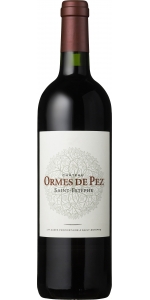Wine from Ormes de Pez

Ormes de Pez has been part of the Medoc landscape since the 18th century. At the time of the French Revolution, the current property was called the Domaine de Pez (meaning ''peace'' in the local dialect). As for the elms (''ormes'') that have appeared on the bottle labels since 2003, they grew on the grounds of the domaine until this mythical variety of tree ceased to grow in Europe in the 1950's.
From the 19th century onwards, the château had numerous owners (Southard and Pieck, Berthé, Carrère, Alibert, Meiners and Allemand, Eschenauer, Johnson, Miaihle), before becoming a part of the Cazes family. In around 1880, Marie Cazes married Jean Guillou, the Ormes de Pez Cellar Master. He was sadly killed at the very beginning of the Great War and so Marie, a woman of great character, subsequently took over the business. Her brother Jean-Charles Cazes purchased Ormes de Pez in 1940. Jean-Michel Cazes later redeveloped and modernised the traditional XVIII century buildings in the early 80's.
Château Ormes de Pez lies 60 km from Bordeaux on the Médoc peninsula. It benefits from a mild ocean climate thanks to its proximity to the estuary and the Atlantic ocean. Its 40 hectares of vineyards consist of two very distinct terroirs: the Cabernets thrive on the gravelly parcels composed of quartz and rolled pebbles whereas Merlot is best-suited to the cooler, sandy-clay parcels. These parcels have good drainage properties and are representative of the Saint-Estèphe appellation. Vines are planted in accordance with the traditional Médoc planting ratio. Cabernet Sauvignon counts for 54% of plantings, complemented by 37% Merlot, 7% Cabernet Franc and 2% Petit Verdot.
Ormes de Pez Saint Estephe is made from 54% Merlot, 38% Cabernet Sauvignon, 4% Cabernet Franc and 4% Petit Verdot.
Château Ormes de Pez 2020 displays deep garnet-purple color with notes of plum preserves and dark berries, plus hints of graphite. Nice chewiness to the texture and lovely freshness, finishing on a lingering fragrant-earth note.
- back
Selected Options
Wineries
Categories
Pricing
Countries
Regions
Grape Types
Wineries
Organic/Free Shipping
An inky purple hue, the wine offers fragrant aromas of ripe, brambly berries and plums, edged in notes of walnut husk and cedar. The palate explodes with intense flavors of redcurrant and cherry, fanning out in a broad, silky wave that mingles vibrant fruit flavors with accents of espresso, chocolate and graphite, and lingers on the long finish.
Review:
A new project from the Indelicato family (Black Stallion Winery) and consultant Thomas Rivers Brown, the 2019 Cabernet Sauvignon is a ripe, full-bodied effort, loaded with scents of cherries, baking spices and dark chocolate accented by subtle herbal shadings. It's supple and expansive on the palate, culminating in a long, mouthwatering finish that combines a touch of warmth and a dusting of silky tannins. It should drink well for more than a decade.
- Robert Parker's Wine Advocate 95 Points
Le Blanc du Chateau des Landes Bordeaux Blanc is made from 50% Sauvignon Blanc and 50% Semillion.
Le Blanc du Chateau des Landes Bordeaux Blanc is a very fruity style of Bordeaux Blanc AOC. It has great aromatic intensity with white peach and citrus aromas.
No oak for this wine. The wine was aged on the lees for a few month in stainless steel tank.
Malolactic fermentation was completed as well in the process .
Excellent as an aperitif, it also goes very well with poultry and salads. If you have a chance to have access to fresh oyters, it is a great match as well.
The first vintage of this wine was made in 2018 as Nicolas Lassagne wanted to create an easy drinking wine that will be perfect as an aperitif in the summer time or to compliment salads and seafood in the winter time.





